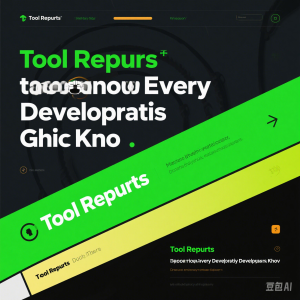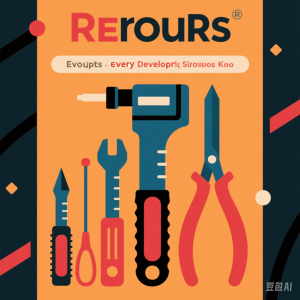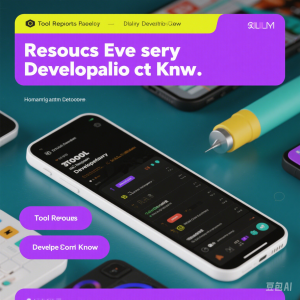Essential Tool Resources for Developer Productivity

In the dynamic world of software development, having the right set of tool resources can be a game – changer for developers. These tools not only streamline the development process but also enhance the quality of the code produced. This article highlights some of the essential tool resources that every developer should consider adding to their toolkit.
Code Editor Enhancements: Beyond the Basics
- Language – Specific Extensions
Modern code editors like Visual Studio Code and Sublime Text offer a plethora of language – specific extensions. For Python developers, extensions such as “Python Indent” help with proper indentation, which is crucial in Python due to its reliance on whitespace for code structure. In JavaScript development, extensions like “ESLint” integrate linting tools directly into the editor. Linting helps catch common coding errors, enforces coding standards, and improves code readability. For example, if a developer accidentally forgets a semicolon in a JavaScript file, ESLint will flag it in real – time, allowing for quick correction.
- Code Navigation and Refactoring Tools
Extensions like “Peek – Definition” in Visual Studio Code are invaluable for code navigation. When a developer hovers over a variable or a function name, this extension quickly shows the definition of that element, even if it’s in a different file. This saves time as developers don’t have to manually search through the codebase. In terms of refactoring, tools like “Rename Symbol” in many code editors can automatically update all references to a variable or a function when its name is changed. This is extremely useful in large – scale projects where a simple name change in one part of the code can have a cascading effect.
Build and Package Management Tools
- Maven for Java Projects
Maven is a widely used build and dependency management tool for Java projects. It simplifies the process of building Java applications by handling tasks such as compiling source code, managing dependencies, and packaging the application into deployable artifacts. For example, in a large enterprise Java project with multiple modules and numerous third – party libraries, Maven can manage all the dependencies. It downloads the required libraries from remote repositories and ensures that the correct versions are used. Maven also has a standardized project structure, which makes it easier for developers to understand and work on projects.
- npm for JavaScript Projects
npm (Node Package Manager) is essential for JavaScript developers. It allows developers to manage project dependencies, install packages from the npm registry, and share their own packages. In a JavaScript web development project, a developer can use npm to install popular libraries like React, Vue.js, or Angular. npm also provides commands for building and running the project. For instance, the “npm run build” command can bundle all the JavaScript files, optimize them, and create a production – ready build. Additionally, npm scripts can be customized to perform various tasks specific to a project, such as running unit tests or linting the code.
Static Analysis and Code Quality Tools
- SonarQube
SonarQube is a powerful static analysis tool that helps in improving code quality. It supports multiple programming languages, including Java, Python, and JavaScript. SonarQube analyzes code for bugs, vulnerabilities, and code smells. For example, it can detect if a Python function has a very high cyclomatic complexity, which indicates that the function might be too complex and difficult to maintain. SonarQube provides detailed reports and visualizations, allowing developers to understand the areas of improvement in their codebase. It can be integrated into the development workflow, such as through continuous integration (CI) tools, to ensure that code quality is maintained throughout the development process.
- Pylint for Python
Pylint is a popular static analysis tool specifically for Python code. It checks Python code for errors, enforces a coding style (such as PEP8, the Python style guide), and detects potential bugs. For instance, Pylint can identify if a variable is declared but never used in a Python script. By using Pylint, developers can write more consistent and reliable Python code. It can be integrated into code editors and build systems, providing real – time feedback to developers as they code or during the build process.
Collaboration – Centric Version Control Extensions
- GitHub – Copilot for GitHub
GitHub – Copilot, an AI – powered code – writing assistant, has become a valuable extension for developers working on GitHub. It can generate code snippets in real – time as developers type, based on the context of the code and the natural – language comments. For example, if a developer writes a comment like “Function to calculate the average of a list”, GitHub – Copilot can suggest the appropriate Python code to implement this functionality. This not only speeds up the coding process but also helps in promoting best practices. Additionally, GitHub – Copilot can be used in a collaborative environment, where multiple developers can benefit from its code – generation capabilities.
- GitLens for Visual Studio Code
GitLens is a powerful extension for Visual Studio Code that enhances the Git experience. It provides detailed information about the Git history of a file, such as who made a particular change, when it was made, and what the change was. In a team development setting, this is extremely useful for understanding the evolution of the code. For example, if a developer is trying to debug an issue and wants to know who
introduced a certain piece of code, GitLens can quickly provide this information. GitLens also makes it easier to review code changes, as it shows the diffs (differences) between versions directly in the editor.
Cloud – Based Development Environments
- Google Cloud Shell
Google Cloud Shell provides a cloud – based development environment. It comes pre – installed with a wide range of development tools, including Python, Java, and Node.js runtimes, as well as popular code editors like Cloud Code for Visual Studio Code. Developers can access Google Cloud Shell from any web browser, eliminating the need to set up a local development environment. In a project that uses Google Cloud services, such as Google Cloud Storage or Google Cloud SQL, Google Cloud Shell provides seamless integration. For example, a developer can use the command – line tools in Cloud Shell to interact with Google Cloud Storage buckets, upload or download files, and manage data.
- AWS Cloud9
AWS Cloud9 is another cloud – based integrated development environment (IDE) offered by Amazon Web Services. It supports multiple programming languages and allows developers to write, run, and debug code in the cloud. AWS Cloud9 has built – in support for AWS services, making it easy for developers to build applications that interact with AWS resources. For instance, a developer can create an AWS Lambda function directly in AWS Cloud9, test it, and deploy it to the AWS Lambda service without leaving the IDE. It also supports team development, with features like real – time collaboration, where multiple developers can work on the same project simultaneously.
In conclusion, these tool resources can significantly enhance a developer’s productivity, code quality, and collaborative capabilities. By incorporating these tools into their development workflows, developers can stay ahead in the fast – paced world of software development.




